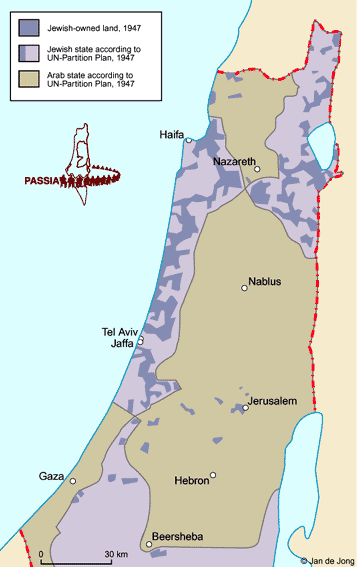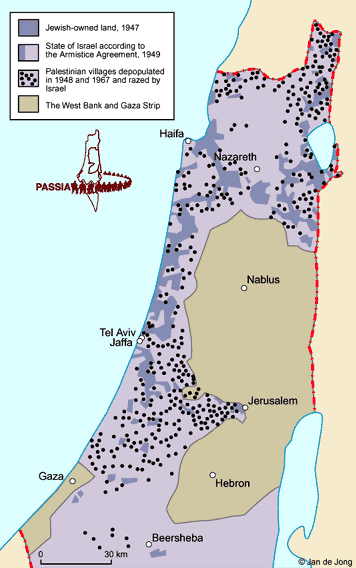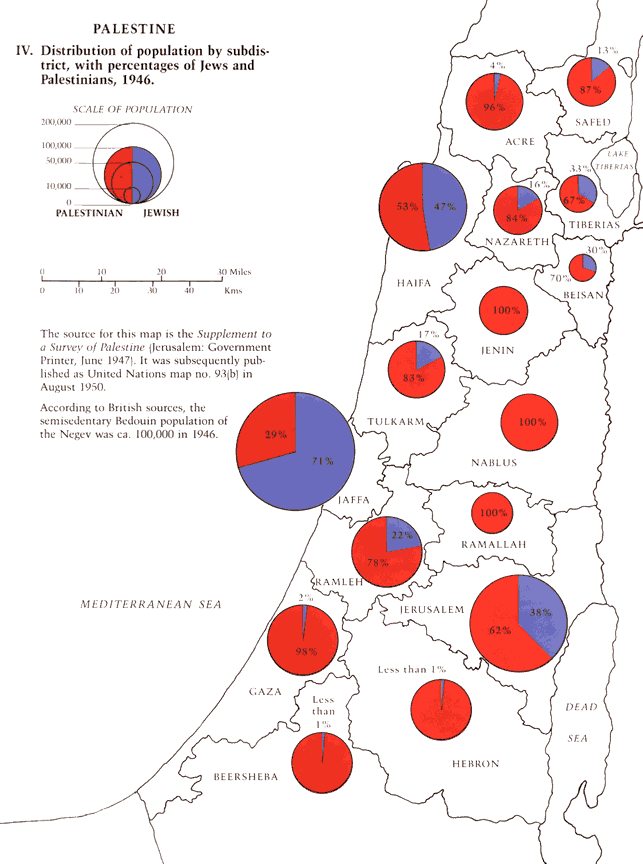How Did We Get Here?
A History of the Israel-Palestine Conflict
3. The Palestinian Refugees of 1948
This is the third of a series of eight lectures, sponsored by
A Jewish Voice for Peace.
This lecture was videotaped on Nov. 4, 2002. The lecturers are Joel
Beinin, a professor of middle east history at Stanford University,
and George Bisharat, a professor at University of California, Hastings
College of the Law.
About Joel Beinin
Professor of Middle East history at Stanford University.
He is currently serving as the President of the Middle
East Studies Association of North America, and is also
involved with the Middle East Research and Information Project (MERIP)
and the Middle East Social and Cultural History Association.
His books include:
- Workers on the Nile: Nationalism, Communism, Islam and the
Egyptian Working Class, 1882-1954 (1987, Princeton University Press;
2000, American University in Cairo Press; co-authored with Zachary
Lockman)
- Intifada: The Palestinian Uprising Against Israeli Occupation
(1989, South End Press; co-edited with Zachary Lockman)
- Was the Red Flag Flying There? Marxist Politics and the Arab-Israeli
Conflict in Egypt and Israel, 1948-1965 (1990, University of California
Press)
- Political Islam: Essays from Middle East Report
(University of California Press, 1998; co-edited with Joe Stork)
- The Dispersion
of Egyptian Jewry: Culture, Politics, and the Formation of a Modern
Diaspora (1998, University of California Press).
- Workers and Peasants in the Modern Middle East
(Cambridge University Press, 2001)
About George Bisharat
Professor at UC Hastings. His study of the impact of Israeli
occupation on the Palestinian legal profession of the West Bank,
Palestinian Lawyers and Israeli Rule: Law and Disorder in the West
Bank, was published in 1989. In recent years, Professor Bisharat has
consulted with the Palestinian Legislative Council over the structure
of the Palestinian judiciary, reforms in criminal procedure, and other
aspects of legal development.
His books include:
- Palestinian Lawyers and Israeli Rule: Law and Disorder in the
West Bank (1990, University of Texas Press)
Chronology
This is expanded from those events mentioned in the lecture, particularly
including events from the British Mandate period (1920-48). The events of
the 1947-49 war are representative but far from complete.
- 1917: Nov. 2: Britain declares Balfour Declaration, pledging
British support for "a Jewish national home in Palestine."
- 1918: Sept.: Palestine occupied by forces under British General
Allenby.
- 1919: Jan. 27-Feb. 10: First Palestinian National Congress in
Jerusalem sends memoranda to Paris Peace Conference rejecting Balfour
Declaration and demanding independence.
- 1920:
- April: First Palestinian revolt, against British breach of
promises of Arab independence and fear of consequences of Zionism.
- July 1: British civilian administration established in
Palestine, with Sir Herbert Samuel installed as High Commissioner.
- 1921:
- March: Founding of Haganah -- Zionist defense organization.
- May 1: Disturbances in Jaffa.
- 1922: Oct.: British census of Palestine shows population
757,182: 78% Muslim Arab, 11% Jewish, 9.6% Christian Arab.
- 1925: Revisionist Party founded by Vladimir Jabotinsky.
- 1929: Aug.: Riots over conflicting claims on Wailing (Western)
Wall in Jerusalem.
- 1931: Irgun Zvai Leumi (IZL) Revisionist militia founded,
under Jabotinsky.
- 1935: Oct.: Revisionists quit World Zionist Organization to
form New Zionist Organization with aim of "liberating" Palestine and
Transjordan.
- 1936:
- Apr. 25: Palestinians form Higher Arab Committee, name Haj
Amin al-Husseini Chairman.
- May 8: Arab rebellion against British begins.
- 1937:
- July 7: Royal (Peel) Commission recommends partitioning Palestine
into Jewish and Arab states, including the transfer of 225,000 Arabs and
1,250 Jews.
- July 23: Arab Higher Committee rejects partition proposal.
- Oct. 1: Britain dissolves Arab Higher Committee; Haj Amin
al-Husseini escapes to Lebanon.
- 1938:
- Apr.-Aug.: IZL bombings kill 119 Palestinians.
- June: British organize Special Night Squads including Haganah
personnel for operations against Palestinian villages.
- Oct. 19: British recapture Old City of Jerusalem from
Palestinian rebels.
- Nov. 9: British Woodhead Commission rescinds Peel Commission
partition proposal.
- 1939:
- May 22-23: British issue White Paper proposing independence
for unitary Palestinian state after 10 years, and restricting Zionist
immigration to 15,000 annually for next 5 years.
- Sept. 1: World War II begins.
- Oct.: Stern Gang (LEHI) formed by dissident IZL members led
by Avraham Stern.
- 1942: Feb.: Avraham Stern killed in anti-British terrorist
action.
- 1944: Jan.: Stern Gang and IZL join to conduct terror campaign
against British.
- 1945: May 8: End of World War II in Europe.
- 1946:
- Mar. 6: Anglo-American Committee of Inquiry arrives.
- July 22: 91 killed when IZL blows up wing of King David Hotel
in Jerusalem housing British government secretariat.
- 1947:
- Feb. 18: Britain submits Palestine problem to UN.
- Apr. 28-May 5: UN appoints Special Committee on Palestine
(UNSCOP).
- Sept. 8: UNSCOP publishes report, where majority recommends
partition.
- Sept. 16: Arab League decides to establish Arab Liberation
Army (ALA), composed of Palestinians and volunteers from other Arab
states
- Sept. 29: Arab Higher Committee rejects partition.
- Oct. 2: Jewish Agency accepts partition.
- Nov. 29: UN General Assembly recommends variant of UNSCOP
partition plan, allocating 56.5% of Palestine to Jewish state, 43% to
Arab state with international enclave around Jerusalem.
- Dec.-Mar. 1948: First wave of Palestinian refugees (according
to Benny Morris chronology), totalling approx. 75,000.
- Dec. 8: Britain recommends to UN that Palestine Mandate be
terminated on 15 May 1948 and independent Jewish and Palestinian states
be established two weeks later.
- Dec. 30-31: IZL terrorist bombs kill Arabs at bus stop outside
Haifa Oil Refinery; Arab workers there turn on Jewish workers, killing 39;
IZL responds with massacre of 60 Arabs in suburbs Balad ash Sheikh and 16
in Hawassa.
- 1948:
- Jan. 8: First contingent of 330 ALA volunteers arrive.
- Jan. 14: Haganah concludes arms deal with Czechoslovakia.
- Apr. 1: Delivery of first arms from Czechoslovakia.
- Apr.-June: Second wave of Palestinian refugees (per Morris),
totalling ???.
- Apr. 4: Haganah launches Plan D (Dalet).
- Apr. 9: IZL and LEHI massacre at Deir Yassin.
- Apr. 15-May 25: British evacuate Safad; Palmah units capture
Safad from ALA and local militia.
- Apr. 16-17: Palmah units capture Tiberias as it is evacuated
by British.
- Apr. 21-22: British forces withdraw from Haifa. Local militia
collapses under Haganah shelling, and population flees.
- Apr. 25: IZL starts mortar shelling of Jaffa.
- Apr. 27-May 5: IZL and Haganah attack Jaffa.
- Apr. 30: All Palestinian quarters in West Jerusalem occupied by
Haganah.
- May 13: Jaffa formally surrenders to Haganah.
- May 14: State of Israel proclaimed. US recognizes state of Israel.
- May 15: British Mandate officially ends. State of Israel comes
into effect. Military units from Transjordan, Egypt, Lebanon, Iraq, and
Syria enter Palestine.
- May 20-22: UN Security Council approints Count Folke Bernadotte
as mediator in Palestine, and calls for ceasefire.
- May 28: Arab Legion (Transjordan) troops take control of
Jewish Quarter in Old City in Jerusalem.
- June 11-July 8: First Truce.
- July 8-18: Period known as "The Ten Days," marked by a major
IDF offensive coming out of the First Truce, leading to the third wave
of refugees (per Morris), totalling approx. 100,000. IDF occupies villages
along Jerusalem-Jaffa road, including Lydda and Ramle, from which the
Arab population is expelled.
- July 18-October 15: Second Truce.
- Sept. 17: Count Folke Bernadotte assassinated by Stern Gang
in Jerusalem. Replaced by Ralph Bunche.
- Oct. 15-Nov. 9: IDF operations resume in Galilee and against
Egypt in Negev.
- 1949:
- Jan.-July: Fourth wave of refugees (per Morris), totalling
100,000-150,000, actually extending as late as 1951.
- Feb. 24: Armistice with Egypt.
- Mar.: Israel completes occupation of Negev down to Eilat.
- Mar. 23: Armistice with Lebanon.
- Apr. 3: Armistice with Jordan. Jordan takes control of territory
gained by Iraq, and cedes Wadi Ara to Israel.
- July 20: Armistice with Syria, with demilitarized zones around
'En Gev and Dardara.
- 1950:
- Mar. 13: Israel passes Absentee Property Law to confiscate
property formerly held by refugees.
- Apr. 24: Unification of West Bank and Kingdom of Jordan.
- May 1: UN establishes UNRWA (UN Relief and Works Agency),
based on Resolution 302.
- July: Israel passes Law of Return, which offers any Jew,
anywhere in the world, full Israeli citizenship.
- 1952: Aug. 11: Israel passes Law of Nationality, which grants
citizenship to non-Jews who can prove continuous Israeli residency since
1948, thus denying citizenship to Palestinian refugees.
Glossary
- Arab Liberation Army (ALA): volunteer armed forces set up by
Arab League to defend Arabs in Palestine.
- Balfour Declaration: in 1917, while WWI is in progress,
Great Britain promises to support the creation of a "Jewish homeland"
in Palestine.
- Eretz Israel: "Land of Israel": the Zionist term for
Palestine before the establishment of modern Israel.
- Haganah: "defense": the militia of the Histadrut (the Jewish
Labor Federation), formed in 1920; the main self-defense organization of
the Zionist community during the Mandate period; with indepenence in 1947
the Haganah became the core of the Israeli Defense Forces (IDF).
- Histadrut: Jewish Labor Federation in Zionist Palestine,
founded in 1920.
- Irgun Zeva'i Le'ummi (IZL): "military national organization":
right-wing Zionist military organization during late British Mandate.
Led by Menachem Begin.
- LEHI: acronym for Lohamei Herut Israel ("Fighters for
the Liberty of Israel"), a right-wing military organization. Also known
as the Stern Gang. Yitzhak Shamir was a leader.
- Mandate: a charter from the League of Nations giving a country
responsibility to administer and develop a former colony. Great Britain
held a League of Nations mandate for Palestine from 1920.
- Mapai: Israeli Workers Party: David Ben Gurion's social
democratic party, the main political party of Labor Zionism.
- Mapam: United Workers' Party, the left-wing of the Labor Zionist
movement.
- Palmah: an elite unit of the Haganah, mostly with military
experience fighting for Great Britain in WWII.
- Stern Gang: See LEHI.
- UNHCR: United Nations High Council on Refugees.
- UNSCOP: United Nations Special Committee on Palestine, formed
in 1947 to recommend solution to Palestine question; majority recommended
partition, which was approved by UN General Assembly, despite Arab
opposition.
- White Paper: any of a series of British position papers, but
especially the May 17, 1939 White Paper which established limits on
Jewish immigration to Palestine and promised Palestinian independence
as a unitary (not partitioned) state in 1949.
- Yishuv: "settlement": the Zionist community in Palestine in
the pre-state period.
Historical Figures:
- King Abdullah bin Al-Hussein (1882-1951): king of Transjordan
1946-1951. A member of the Hashemite dynasty, son of the Sherif of Mecca,
who had collaborated with Britain to revolt against the Ottoman Empire
during WWI, brother of King Feisal of Iraq. Met with Golda Meir in 1947-48,
who urged him to invade and annex parts of the Arab partition of Palestine,
to prevent formation of an independent Arab Palestinian state.
- Count Folke Bernadotte (1895-1948): UN appointed mediator;
assassinated by Stern Gang.
- David Ben-Gurion (1886-1973): leader of Histadrut and Mapai, from
early 1930s the main political leader in the Yishuv; directed Haganah in
Israel's 1947-49 War of Independence, becoming first Prime Minister
of Israel.
- Haj Amin al-Husseini (1893-1974): member of leading family in Arab
Jerusalem; appointed Mufti of Jerusalem by British in 1921; led Arab
Revolt in 1936, soon going into exile; collaborated with Nazi Germany
during WWII.
- Vladimir Jabotinsky (1880-1940): early right-wing Zionist leader
and theoretician; author of "The Iron Wall"; leader of Revisionist Zionism,
which eventually leads to today's Likud party.
- Golda Meir (1898-1978): Labor Zionist leader, close associate
of Ben-Gurion, and eventually Prime Minister of Israel. She was sent to
negotiate with King Abdullah Jordan's annexation of the West Bank.
- Yitzhak Rabin (1922-1995): commanded Harel Brigade in IDF,
responsible for expulsion of Palestinians in Lydda and Ramle in 1948;
later Chief of Staff during 1967 war, twice Prime Minister of Israel.
- Avraham Stern (1907-1942): founder of Lochemay Herut Yisra'el
(LEHI), also known as the Stern Gang.
- Yosef Weitz (1890-1970): Jewish National Fund leader, a major
advocate of the "transfer" of Palestinians refugees in 1947-49.
- Chaim Weizmann (1874-1952): head of Zionist Commission from 1918,
which worked with Great Britain to implement Balfour Declaration in Palestine.
Later head of Zionist Executive, and ultimately first President of
Israel.
Suggested Readings
The following titles were recommended on the website:
- Benny Morris, The Birth of the Palestinian Refugee Problem,
1947-1949 (1987, Cambridge University Press)
- Ilan Pappe, The Making of the Arab-Israeli Conflict, 1947-1949
(1992, I.B. Tauris)
- John Quigley, "Displaced Palestinians and a Right of Return",
39 Harvard International Law Journal p. 171 (Winter, 1998) (a concise
statement of the legal basis for a Palestinian right of return, and
responses to common objections to such a right)
- Gail Boling, "The 1948 Palestinian Refugees and the Individual Right
of Return: an International Law Analysis", Badil Resource Center for
Palestinian Residency and Refugee Rights,
available online
(argues that Palestinian right of return is rooted in four areas of
customary international law; 52 pages)
- Amnesty International, "The Right to Return: the Case of the
Palestinians",
available online
(2-3 pages; very concise statement of international legal basis of right
of return and AI's policy in support of Palestinian right of return).
The following are useful books that we are familiar with and recommend:
- Tom Segev, One Palestine Complete: Jews and Arabs Under the British
Mandate (2001, Owl Books, paperback)
- Benny Morris, Righteous Victims: A History of the Zionist-Arab
Conflict, 1881-2001 (2001, Vintage Books, paperback)
- David Fromkin, A Peace to End All Peace: The Fall of the Ottoman
Empire and the Creation of the Modern Middle East (2001, Owl Books,
paperback)
- Avi Shlaim, The Iron Wall: Israel and the Arab World (2001,
W.W. Norton, paperback)
- Norman G. Finkelstein, Image and Reality of the Israel-Palestine
Conflict (2nd edition, 2003, Verso, paperback)
Links
Maps
The map on the left below shows the UN Partition Plan of 1947, with the
land actually owned by the Yishuv shaded darker. It should be noted that
the UN Partition Plan actually called for the overwhelmingly Palestinian
city of Jaffa to remain with Arab Palestine, and for Jerusalem and a
surrounding area (including Bethlehem) to remain under international
supervision and control.
The map on the right shows the same land ownership, but with the borders
moved to reflect Israeli territorial gains in the 1947-48 war. The black
dots represent Arab towns and villages which were depopulated during the
war, and destroyed by Israel to prevent return.

UN Partition Plan 1947
|

Armistice Agreements 1949
|
This is a map showing the population breakdown between Jews and native
Palestinians as of 1946.





